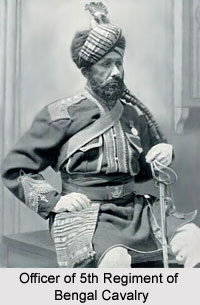 The 5th Regiment of Bengal Cavalry, also known as the 5th Cavalry Regiment or simply as 5th Cavalry, was an irregular Cavalry Regiment. The military unit was formed as the 7th Irregular Cavalry in the year 1841 at Bareilly, Uttar Pradesh. It was developed as a consequence of the First Afghan War. The battalion also participated in the Second Afghan War from 1878 to 1880. The army regiment was a part of the Bengal Army under the British Indian Army. The Army of Bengal Province was the armed forces of Bengal Presidency and was amongst the 3 main Presidency Armies in British India. The British Presidency Armies belonged to the British East India Company until the Sepoy Mutiny of 1857. The Government of India Act 1858, which was authorized after the Sepoy Mutiny in the year 1857, transferred the authority of the 3 Presidency Armies to the British Empire in India. Later the 3 separate presidency armies were united to form the combined British Indian Army. The unit also participated in the First World War and the Second World War.
The 5th Regiment of Bengal Cavalry, also known as the 5th Cavalry Regiment or simply as 5th Cavalry, was an irregular Cavalry Regiment. The military unit was formed as the 7th Irregular Cavalry in the year 1841 at Bareilly, Uttar Pradesh. It was developed as a consequence of the First Afghan War. The battalion also participated in the Second Afghan War from 1878 to 1880. The army regiment was a part of the Bengal Army under the British Indian Army. The Army of Bengal Province was the armed forces of Bengal Presidency and was amongst the 3 main Presidency Armies in British India. The British Presidency Armies belonged to the British East India Company until the Sepoy Mutiny of 1857. The Government of India Act 1858, which was authorized after the Sepoy Mutiny in the year 1857, transferred the authority of the 3 Presidency Armies to the British Empire in India. Later the 3 separate presidency armies were united to form the combined British Indian Army. The unit also participated in the First World War and the Second World War.
Operations of 5th Regiment of Bengal Cavalry
The 5th Regiment of Bengal Cavalry of the British Indian army provided military service in India and overseas as well. The regiment also participated in the conquests in Bhutan, Palestine, Afghanistan and Mesopotamia. The military unit of the 5th Regiment of Bengal Cavalry was merged with the 8th Cavalry regiment (also known as 8th Regiment of Bengal Cavalry and 17th Irregular Cavalry) in order to form the 3rd Cavalry regiment of the British Indian Army in the year 1922. The 3rd Cavalry later provided service on the North West Frontier. The 3rd Cavalry was honoured with Battle Honours for Central Malaya and North Malaya. The 3rd Cavalry regiment was dissolved in the year 1946.
Designations of 5th Regiment of Bengal Cavalry
The 5th Cavalry Regiment, also designated as the 7th Irregular Cavalry, of the British Indian Army held a number of designations through out its existence during the restructuring of the army, like all the other regiments. These are mentioned below-
* 7th Irregular Cavalry (1841)
* 5th Regiment of Bengal Cavalry (1861)
* 5th Bengal Cavalry (1901)
* 5th Cavalry (1903)



















